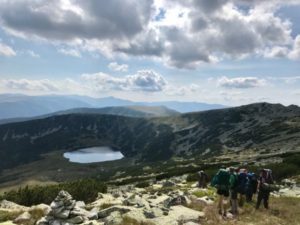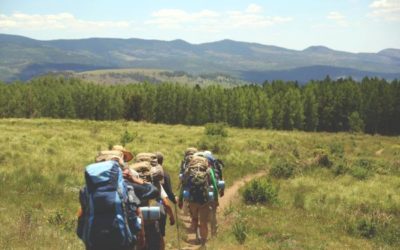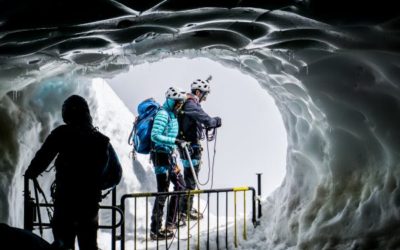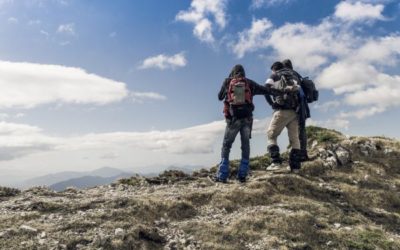I was on a personal trip with a good friend of mine, snowshoeing through the Yosemite backcountry in early February. Winter in the high Sierras of California is quite an amazing time to experience the mountains. We had planned a light and fast trip, to enable us to knock out a few fun objectives. We had planned to filter water in the dozen or so streams that our route crossed throughout the course of our trip, instead of melting snow. When we got to our first camp, my partner had gone to get water as I dug out our tent platform. Almost an hour had gone by, and I started to get really worried about him. I yelled for him quite a few times, no response. Another half-hour passed and I finally saw him coming up the hill from the stream. Relieved to see him, I jumped up from making dinner to ask where he had been.

Photo by Andrew Underwood
It seems that we had failed to calculate that the snowpack. It was 25ft (~7.5 m) deep, which would create quite the challenge of getting down to the stream. He had to use his snowshoes to cut a ramp down to the water, which obviously took a lot of time and energy. This was also the moment that we realized we would have to cross, at least four of these streams, the next day. Needless to say, we learned a few valuable lessons about winter backcountry travel in the Sierras that trip.
Water is Critical to Route Planning
Water, of course, rounds out the top three of “Ten Essentials” for backcountry travel. All living things can get nutrients from all sorts of creative “food” sources but nothing can live without water. So, take the lesson from me, proper planning needs to be given to how you will handle water on a trip. Here are a few key factors that you should keep in mind when it comes to water.
- Plan your route, down to the hour with water in mind.
- Water must be treated. Methods depend on your group size, trip type, and water sources.
- Some water sources are seasonal; Know your climate, ecology, and map designations (where available).
- You and your participants should plan to drink about .25L per hour to stay adequately hydrated. This could vary based on individual, ecosystem, climate, and type of activity.
- We recommended that each participant carries at least 2L and guides should consider an additional liter. This could vary based on the ecosystem, climate, and type of activity.
Water Teaches Us That God is the True Giver of Life
“Cursed is the one who trusts in man, who draws strength from mere flesh and whose heart turns away from the LORD. That person will be like a bush in the wastelands; they will not see prosperity when it comes. They will dwell in parched places of the desert, in the a salt where no one lives. But blessed is the one who trusts in the LORD, whose confidence is in him. They will be like a tree planted by the water that sends out its roots by the stream. It does not fear when the heat comes; its leaves are always green. It has no worries in year of doubt and fails to bear fruit.” Jeremiah 17:5-8
Jeremiah gives us a powerful analogy, comparing one whose strength is found in their own flesh and the one whose trust is in the LORD. The image given to us for this comparison is of two plants, one struggling to grow in the parched soils of the desert and the other rooted by a stream. The bush that flourishes is the one closest to the life-giving power of the water in the stream. It gives it strength, even when the harsh summer heats beat down on it. This source of strength gives the plant the ability to flourish in every season, always producing good fruit. This image helps us see that whoever is “rooted” in the life-giving presence and strength of the LORD will truly flourish forever.
Let Water Guide Us to the Gospel
Jesus was talking about this very thing with the women at the well in John 4. He tells her that He alone is the wellspring of living water that leads to eternal life. When we thirst after and find our hope in Him, we will be brought from the wasteland of our fleshly desires into life by the stream, never to thirst again. John continues to make this point for us as we see the side of Jesus pierced open and the blood of the lamb pours out, alongside water of all things. What a life-changing image; Jesus is the true fountain of living water. Demonstrating his love for us, His life “poured out” so that through His death we may have eternal life; wow. Who knew that we could use the water in the wilderness to share the Gospel of Jesus Christ? As you are planning your next trip, give some attention and planning to how you might use water as a powerful teaching tool to lead those you are serving to the feet of Jesus.
Reflection
- What are 3 challenges with water that you might face in planning your next trip?
- Can you think of other examples in scripture that water is mentioned? List Three.
- How might you use a stop to refill water bottles as a moment of learning for your students?



